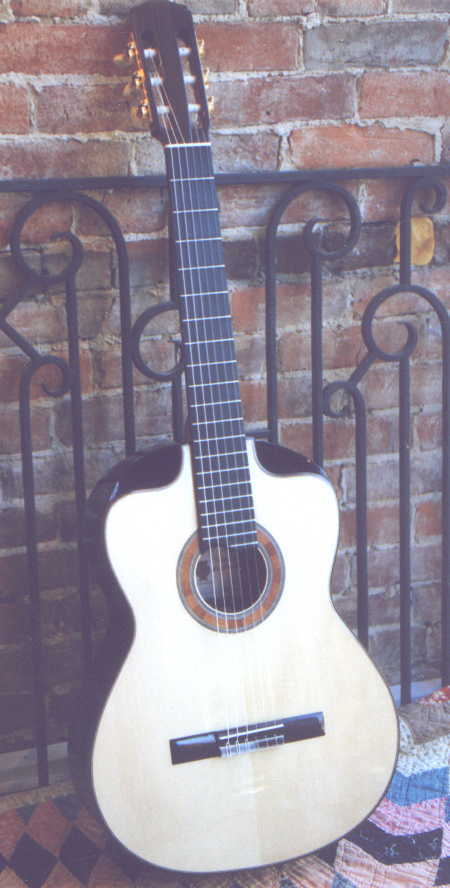
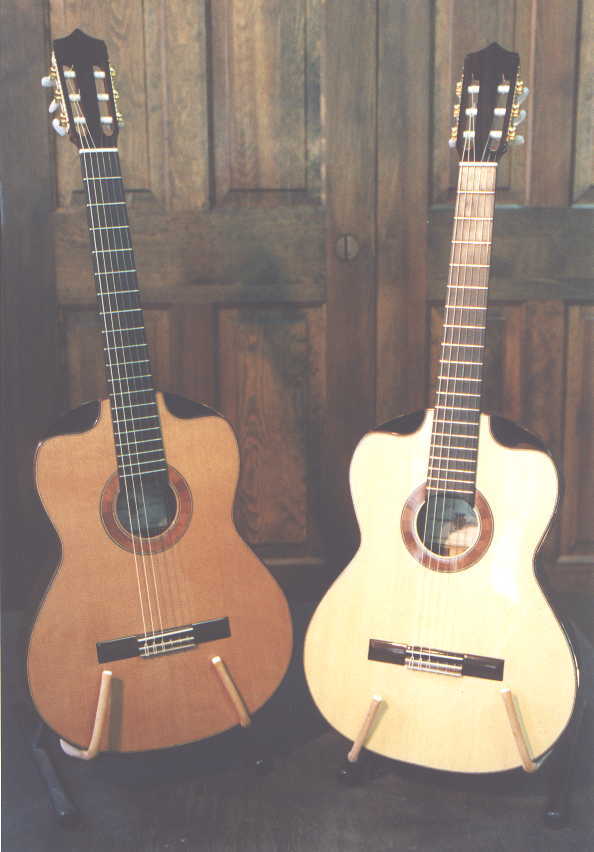
(U.S. Patent #5, 952,591)
send email to: rogluthier@aol.com
Specifications and Photos of the LoPrinzi Nova Futura Classic Guitar
(New! At the bottom of this page read recent Internet Discussions of the Nova Futura and other ported guitar designs.)
Find out about:
Artists
Who Play the LoPrinzi Nova
Futura
Scale: 650 mm. or 664 mm.
Soundboard: Spruce or Cedar
Back and Sides: East Indian Rosewood
Fingerboard: Ebony with a bone nut.
Finish: Traditional Oil varnish polished to gloss.
Tuners: Gotoh
Binding: Marquetry purflings on front. Straight "Hauser style" multi-strip
body binding and back joint.
Bridge: Rosewood with a bone saddle.
Special: "Thurman Multi-dimensional Sound Ports" for enhanced projection
and playability.
Price: $4000 including hard case.
Availability: Now! Call 888-803-8693


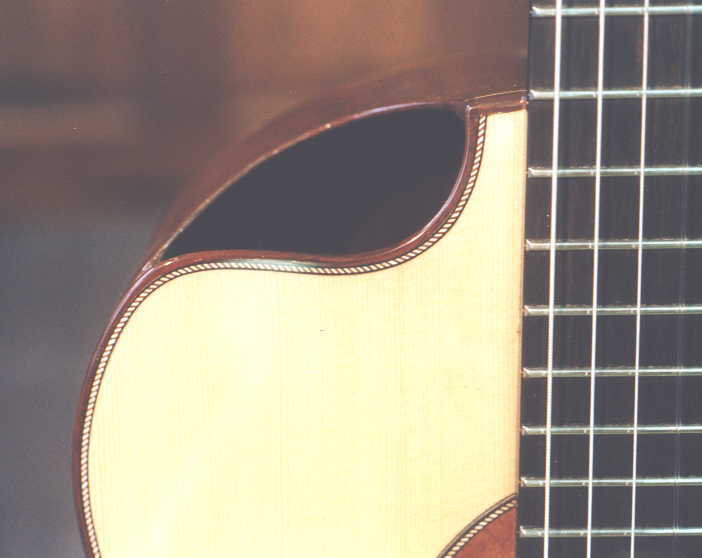
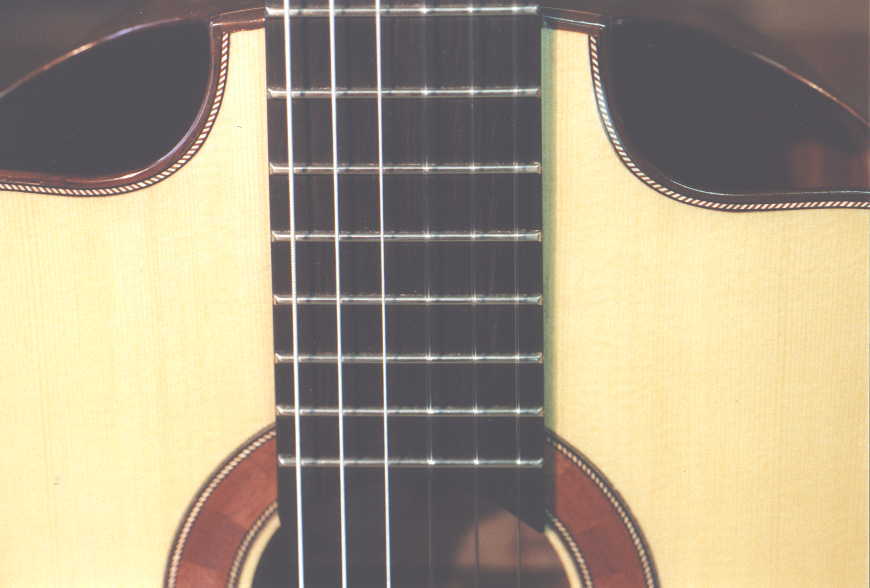
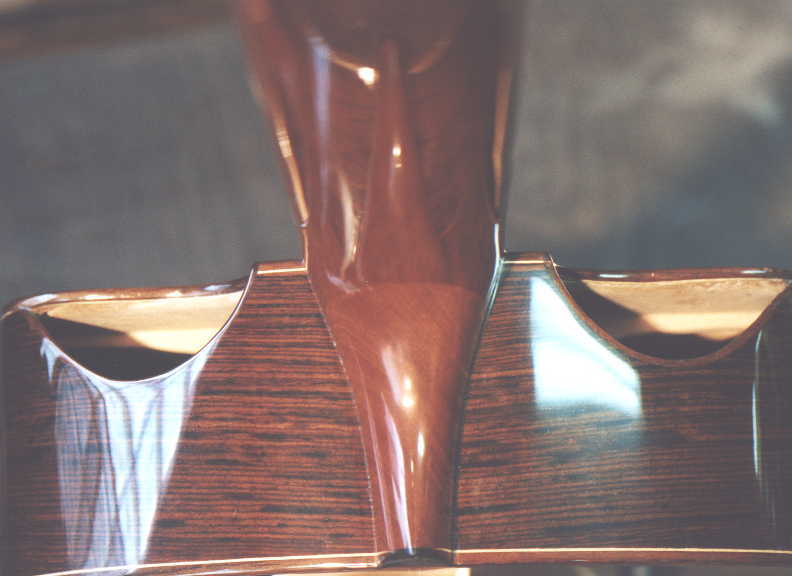
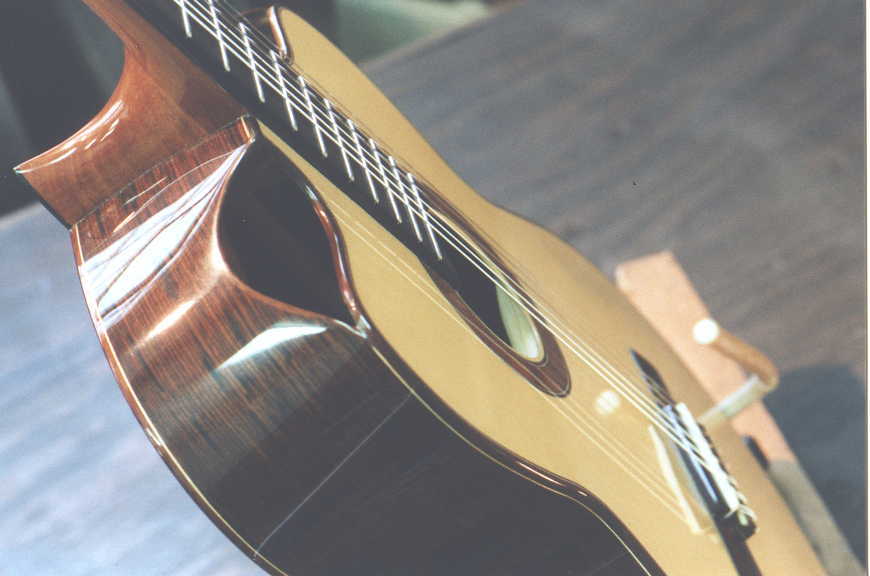

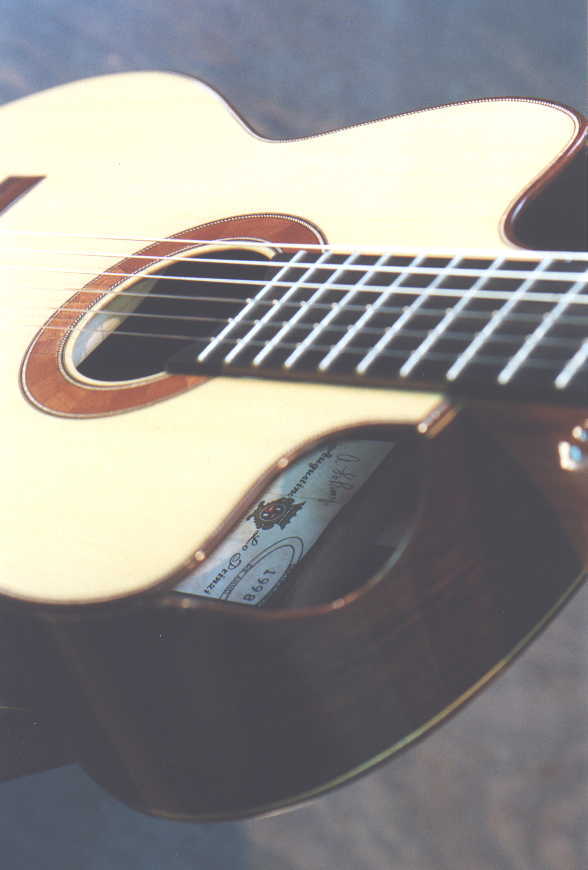 .
.
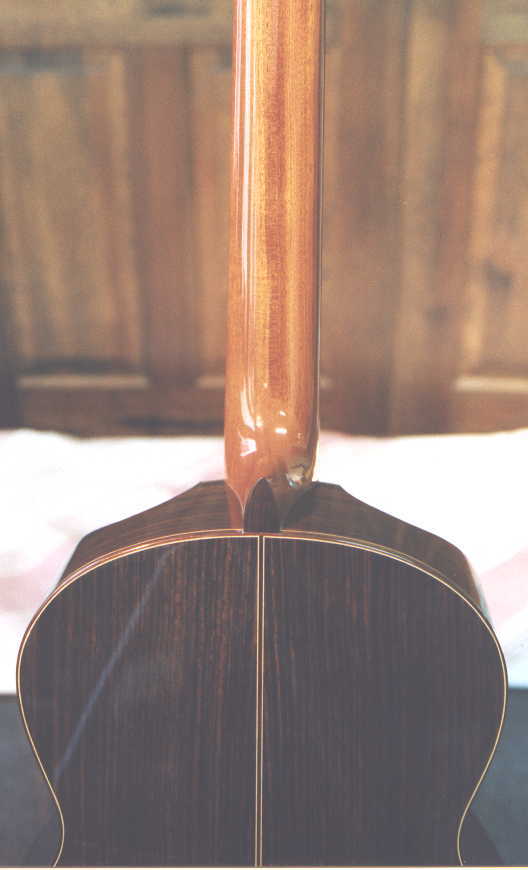
Thurman Multi-dimensional Sound Ports
Notice how the upper sound ports cross over the edge of the instrument. This angles the ports at almost 45 degrees, thereby aiming them directly into the lower bout where sound is generated. At least four enhancements occur:
1. - There is an increased projection and clarification of the tone because sound trapped in the upper bout is liberated, and does not dampen successive sound waves generated by the bridge in the lower bout. The increased soundboard efficiency brightens and clarifies the tone; sustain and attack are enhanced and intensified.
2. - The Multi-dimensional port toward the musician functions like a monitor so the player can easliy hear the instrument in a way totally impossible with the traditional design.
3. - Easier access (by at least two fret positions) for the notes over the body. The hand is freer to reach for the higher notes and barred positions.
4. - The inhanced sound projection fills in a broader pattern and is distributed more generously and efficiently than guitars equipped only with the traditional sound hole. If you place your hand over an upper sound hole and strum a full chord the pressure of the increased sound projection is dramatic and easily detected. If you block the multi-dimensional ports the instrument is immediately dampened.
This beautiful design principle does not interfere with the traditional development of soundboard theories, bridge designs and bracing patterns. It simply allows the guitar to become a more efficient acoustic device (air pump) and thereby improves upon all the other work accomplished by traditional luthiery to date. The LoPrinzi Nova Futura, in cedar or spruce soundboard, is now available. Please call for information about the nearest dealer.
GFA - Montreal (Oct. 18 - 24, 1998)
Displaying the LoPrinzi Nova Futura at the recent GFA in Montreal was a wonderful experience. I had to demonstrate it to so many different people and make note of their reactions. Accordingly, I got a lot better at explaining it and also spent more time reflecting about this instrument which bears my invention, the Thurman Multi-dimensional Sound Port (TMSP). I hope you don't mind if I indulge myself by recapping the goals, claims and theory behind this effort. This is an exciting time, watching this new instrument make its way in the classical guitar community. My sincere thanks to Augie LoPrinzi, a great guitar maker at the top of his profession, whose willing collaboration and sublime skill has made this dream into a reality.
Thurman Multi-dimensional Sound Port (TMSP)
Goal:
Dramatically increase the acoustical and ergonomic efficiency of the guitar while retaining as much traditional design, materials and construction as possible.
Claims:
*Enhanced projection of trapped sound liberated from the upper bout.
*Improved access to higher fingerboard fret positions over the body by at least two frets.
*Monitor effect to provide the player an accurate impression of what the audience listener hears.
*Efficient distribution of a larger sound in a broader pattern in front of the player.
Background and Theory
Luthiers have "hit the wall" in terms of increasing the acoustical efficiency of the traditional guitar design. Soundboard dimension, bracing patterns and finishing techniques have been intensively explored with but modest and unpredictable success relative to the efforts. Older instruments are still highly prized and, surprisingly, often outperform the best recent work. This would not be the case if the elaborate "luthier science" theories of the past 20 years had really borne fruit.
The problem with "luthier science" is the assumption that the traditional design is near perfection and that very little else can, or should, be done to improve it. As a repairman, guitar maker and player, I have been put on this earth to improve things, not to replicate the mistakes of the past. Although I adore the form and historic lore of the traditional design I must acknowledge and confront its limitations, especially in view of our own age which emphasizes science and technology. Our hearing is conditioned by our sonic environment which, if not wholly alien, is vastly different from the milieu of Torres, Tarrega and Andres Segovia. My responsibility is to blend the old with the new in an inspired and logical way, which brings the beauty of antiquity forward without destroying the past.
In terms of acoustical efficiency I regard the traditional design as seriously flawed. This is a source of much frustration for both guitar makers and players who strive to express themselves acoustically in world reverberant with noise. I want to make a guitar with stronger, pure and more interesting voice which will stand up to the psycho-acoustical interference (noise) conditioning of our times.
The Thurman Multi-dimensional Sound Port (patent applied for) as embodied in the Augustino LoPrinzi Nova Futura demonstrates that there is excess internal acoustical activity created by the player which does not reach the audience. This trapped sound becomes destructive and effectively damps the sound board, limits attack duration, sustain and induces a "dull" component to the tone of the most finely wrought examples of the classical guitar.
As a consequence of the square-cornered rounded shape and tonewoods, the guitar produces many natural resonances some of which are more responsive and prominent than others. Most important of these is the body cavity resonance which is the lowest natural frequency of the guitar and the most mechanically active note. These natural resonances -- easily triggered by normal playing -- dampen and interfere with other notes that do not have a natural support resonance. The TMSP liberates this excess activity, especially the body cavity resonance, by efficiently clearing it from the body for conversion into useable sound. Subsequently, the sound board itself is no longer damped and responds more quickly to the player's touch in both greater detail and amplitude. The result is a guitar which sounds better and feels easier to play because it is naturally responding more efficiently to every aspect of player input.
Frequently Asked Questions:
Why keep the traditional sound hole?
Many fine guitars have been made with the traditional sound hole placement. It makes no sense to eliminate a vital component which is so integral with the design and aesthetics of the guitar. Indeed, the LoPrinzi Nova Futura design retains the traditional sound hole and confirms its validity. If the traditional sound hole is blocked certain frequencies and overtones are muted. This shows that the Thurman Multi-dimensional Sound Ports (TMSP) liberate sound which the traditional hole does not, and vice versa. Indeed, the TMSP and the traditional sound hole work together to produce a reinforced sound with greater depth and clarity than before.
Why not place the TMSP elsewhere rather than the upper bout?
The TMSP, if placed in the lower bout, is minimally effective in comparison with the major enhancements provided by the bilateral upper bout location (improved fret access, monitor effect, etc.). Moreover, the goal is to preserve as much as possible the traditional "look" of the guitar. Prior to the TMSP it was thought that the upper bout of the guitar had little function other than receiving the neck. After the TMSP it is clear that the upper bout can be used meaningfully to enhance the sound and playability of the guitar. By keeping the TMSP in the upper bout all the excellent characteristic work done by various luthiers to develop the sound board bracing in the bridge area is unaffected.
Why is the TMSP "multi-dimensional?" Isn't it just another sound hole?
The traditional sound hole, or a hole placed anywhere on the sound board, is aimed directly at the guitar's back. The TMSP, opening the sound board and side simultaneously, is by design aimed diagonally into the lower bout where sound is generated. It is therefore in a very strategic position to not only liberate and project forward sonic activity moving up from the lower bout, but to also provide the monitor effect and facilitate better access to the higher positions. This is why it is termed "multi-dimensional," because it spans more than one plane but also confronts and solves other sound production and playability issues.
The Results:
The most important effect is the liberation of sound because it creates a virtual cascade of secondary results: expanded dynamic range, clarity and depth of tone across all registers, longer attack and sustain, easier access to tone color variations, enhanced sensitivity and tonal saturation at the lower volume levels. The sound of the LoPrinzi Nova Futura with the TMSP is not only larger in scope and volume but it is also an interesting sound with its own identity. This identity is more in the direction of the piano in scope and depth. Therefore, I believe it is appropriate to refer to the LoPrinzi Nova Futura as the "grand piano" of the classical guitar.
After 25 years in luthiery this is my attempt to objectively assess our instrument and to provide a solution and a direction. I realize this may not satisfy or please some. I am committed to the future of the classical guitar and this "fix" of mine to the traditional design is but an offering toward the further development of our instrument.
Internet Discussion of the Nova Futura and other ported guitar body designs.
<< So, as you've guessed by now, I took one of my old yard sale practice guitars and drilled a one inch hole in the upper bout approximately 1-1/4" from the neck. The guitar is without doubt much louder to my playing ear and my friend says it is actually louder out front.
So tell me, is there something to this and does it advantage the guitar? Perhaps there is a downside to this such as loss of tone? Or maybe, just maybe, I've just had a momentary lapse of reason? Such a thing almost seems too simple. >>
Kevin:
I was next to Kenny Hill at the Charleston SC GFA. We are both believers in ported guitars. You are going to see, and hear, much more of this idea in the future. Very simply, the ports help the guitar become a more efficient acoustical device. This especially helps guitars when they are new and the tone is unformed. As the ported instruments age the effect is even greater.
The results shock people at first hearing and even offend sensibilities that believe the guitar can go no further than what has already been done. Yet, the instrument has developed so recently, compared with the violin, that most of the designs we now accept contain elements which deviate significantly from the past. Torres, Fleta, Hauser, Ramirez, Bouchet, Gilbert, Humphrey, Smallman and Daumann have all innovated in their own times. What is really different about the ports is the engagement of a problem beyond the scope of all previous innovations which have sought to understand and control the vibrations in the materials of the instrument, primarily the soundboard and back.
In our times, Michael Kasha and Carleen Hutchins began to research the instrument from a scientific viewpoint. Their important work has influenced anyone who came in contact with it. Luthiers have taken this knowledge, mixed it with tradition, and articulated valuable new ways of understanding how to reduce the friction of the materials. These developments, however successful, have been confined to the traditional form and have therefore overlooked the necessity of also reducing the friction of air movement. Simply put: what is the point of improving the soundboard function if the containment and movement of air is not similarly addressed?
The Ruck/Hill holes are a step in the right direction and were conceived and appeared after finding out about the multi-dimensional sound ports utilized by Augustino LoPrinzi's Nova Futura. The multi-dimensional ports are more radical but really deliver the goods, so to speak. Whether or not they will be accepted is another question because there are many reasons, other than pure sound efficiency, why people prefer one guitar over another. In the long run I believe the ported designs will find success because the results, as Kevin noticed, are really there and plainly evident.
Roger Thurman
In a message dated 1/27/00 3:17:02 AM Eastern Standard Time, Adam writes:
<< Before we leave the thread of Mr. Thurman's sound ports (and Mr. Ruck's holes), I have a question both for the inventor and anyone who has played these guitars. What effect do these ports/holes have on the guitars tonal palette and wolf tones? In other words do these things only affect volume or do they impact the performance of the guitar as a whole?>>
The diagonal orientation of the sound ports (relative to the axis of instrument) helps produce not only more volume but also greater evenness, clarity and immediacy to the guitar's response. By spanning the very strategic internal corners of the upper bout, distorted and trapped sound waves, especially the profound low body cavity resonance, are instantly liberated. This produces a chain reaction throughout the entire instrument and a net improvement in the mechanical efficiency. The attack is quicker and sustains longer. The dynamic range expands which means that there not just more volume but the instrument performs more efficiently at pianissimo levels. Volume is important but this invention would be useless if that were the only result.
<< Of course I realize that they must have some effect on the tone and overall characteristics of a guitar as guitars are organic and the various tonal functions are interrelated in an indivisible manner. My question is perhaps better phrased as asking what is the most noticeable impact of this modification, everyone has been talking about volume, but what about tonal variety and wolf tones, Does a guitar with these modification tend to have fewer dead spots and a broader tonal palette than a guitar without the ports, or assuming two relatively identical guitars will the ported guitar simply be louder?>>
I believe that the wolf tones and uneven spots that have bedeviled luthiers are largely caused by the inherent acoustical liabilities of the traditional design. Some very talented guitar makers have tried their best, with valiant but uneven results, to get around this problem but the efforts are undercut by adhering dogmatically to the traditional design. You have asked some very important questions especially when comparing two hypothetically equal guitars, with and without ports. Yes, when side by side the improvements to tone and function provided by the multi-dimensional sound ports are immediately evident. To the player the guitar responds quicker, is easier to play and sounds richer and deeper. For the listener, the bass is full, the mids stronger and the higher frequencies leap out of the guitar as never before, especially those notes over the body. The guitar is just easier to hear.
<< My second question is for Mr. Thurman, is this a potential modification for existing guitars? Can we look forward to the development of a porting system for existing guitars? Is this something I could consult my luthier about? Well I am fascinated by new guitar developments and I could go on and on with my questions, but I will stop here....>>
Of course it is a "potential" modification `([;}-) However, that would be an infringement of the patent. I am not licensing or encouraging such changes because to be fully realized the invention should built into the guitar from the ground up. There need to be some structural reinforcement and aesthetic refinements which are best accomplished to a new instrument. The last thing I want to see happen is fine individual guitars abruptly and poorly modified without the original maker's knowledge or approval. Older guitars develop a wonderful sound which only comes with age and therefore have a validity which shouldn't be modified since a point in time and history is embodied and ennobled.
Ported designs do not replace all other guitars but represent another, albeit new, type of guitar to fit alongside all the other instruments which have been created. Despite all I've said about the improvements afforded by my invention, it is entirely possible and rational for a player to prefer the "character" of the traditional design over the "character" of the ported design. There are many reasons for a given personality to like or dislike the aesthetics of a given instrument and the presence of ports, in my opinion, does not have to be the sole defining term. However, if you like what you hear in a ported design then, by all means, go for it! (Kenny Hill and I have.)
As to licensing, I will communicate with any qualified luthier sincerely interested in using this invention. All I need is a signed letter expressing such interest (not email) and I can refer the matter to my attorney for consideration. The fee is strictly a private matter. It is structured to encourage licensed makers to incorporate the invention into a regular model. We are arriving at a point where we need more good guitar makers incorporating this into their work. My intent has never been to selfishly keep this to myself. The patent law is a means by which I receive credit and financial benefits for developing and promoting the invention to ultimately share it with others. BTW if you want to order one from another maker, Richard Brune has acknowledged the effectiveness of this invention from the first time he heard one. Richard has been behind me from day one on this and has told others so. I thank him for such approval.
A word about "Ruck's" ports. These happened after I spoke with him a couple of years ago about licensing this idea (my number was imminent on his list). A prototype was sent for his inspection and he decided against it, because of the difficulty and the patent fee. Previously, there was a round of faxes and communications with Jerry Roberts who modified a ramped guitar with drilled holes years ago. Mr. Roberts, who already has plenty of intellectual property, was cattily objecting to anyone else patenting an original idea. This didn't make too much sense to me so you can guess where I told him to go. Roberts and Ruck have a long association so it's easy to see why the drilled "Ruck" holes suddenly appeared: in reaction to a patented invention, the Thurman multi-dimensional sound port. (Enter Kenny Hill at this point.)
Do the Ruck holes work? They certainly do. I played one at the Charleston SC GFA and approve of their efforts with the ported design. That type of hole has been done many times by various guitar makers. The multi-dimensional sound port goes much further in both tone production (especially frontal projection) and ergonomics. I like and recommend the Roberts-Ruck-Hill ports because they are not as radical as the multi-dimensional port and offer a reasonable option to players who are put-off by the look of my invention. However, if you really want to step up to the plate and hit a home run......need I say more?
As we place more LoPrinzi Nova Futura users in the field I will gather some of their comments for future publication on my web site. We're not advertising and have received no press coverage, but the guitars are selling thanks to the productivity and genius of Augustino LoPrinzi, one of the great guitar makers, who has brought this invention to the guitar community at an affordable price.
On 1/28/00 Rick wrote:
<<I played the LoPrinzi Nova Futura at GFA and was quite impressed with the sound feedback I received while playing. The LoPrinzi also projected very well in the auditorium setting .... it was one of the loudest guitars of the twenty or so that were demonstrated. As an aside, Augustino LoPrinzi and Roger were both delightful to talk to about their guitars.>>
On 1/27/00 Clyde wrote:
<<...I would like to tell everybody that I tried out one of Roger's instruments at the Charleston GFA vendor's fair and was delighted with the instrument's sound. I dare say if I had the currency (or a way of procuring it) I would have my order in with Roger for a new instrument right now. The instruments are not only louder, but have great clarity in all registers in the elevation of projection caused by the ports.
On a more controversial note, Roger had discussions with Ruck about the use of his ports on Ruck instruments (see for yourself at Roger's website). Ruck then sidestepped the licensing issues by coming out with an instrument with small golf ball size sound ports on the side of the instrument (one on either side of the neck/body juncture). The Ruck instrument does have more projection than a standard instrument, but the increase in the mechanical sound is not an increase in sound that would be desired. The treble was OK, but the bass strings emitted almost wolf note characteristics.
Hope I didn't rub any nerves here, but I felt the truth should be known.>>
On 1/28/00 Larry wrote:
<<Hi Clyde & group,
Thank you for your information and opinion on these guitars. You seem to be the only one other than the luthiers themselves who have tried both types of guitars (or who have bothered to write in about it). So far, I have only tried the Hill model, and that was only because one happened to turn up in a store of a friend mine's here in Kansas City. I was favorably impressed, but I am looking forward to trying one of Roger Thurman's guitars as soon as possible.
As far as the bass strings, I didn't notice any "almost wolf note characteristics" on the one I tried. In fact, I thought it was a very well balanced instrument. The only problem for me was just getting used to the monitoring effect. It is definitely louder for the player than a conventional guitar, and was a shock to me at first, because it was so different from what I was used to hearing from my own playing. But, I don't think this a necessarily a bad thing, its just different. All in all, as far as my opinion on either type of guitar, I very much like the potential of being more of an equal in the ensemble playing I do.>>
Go to: Performers and Players Using the LoPrinzi Nova Futura Classic Guitar
© Roger G. Thurman 1998-2008
All material on this this website is protected under international copyright law and as such is prevented from being used for any other purpose without express written approval
Thurman Guitar & Violin Repair, Inc.
900 Franklin Av.
Kent OH 44240
330-673-4054